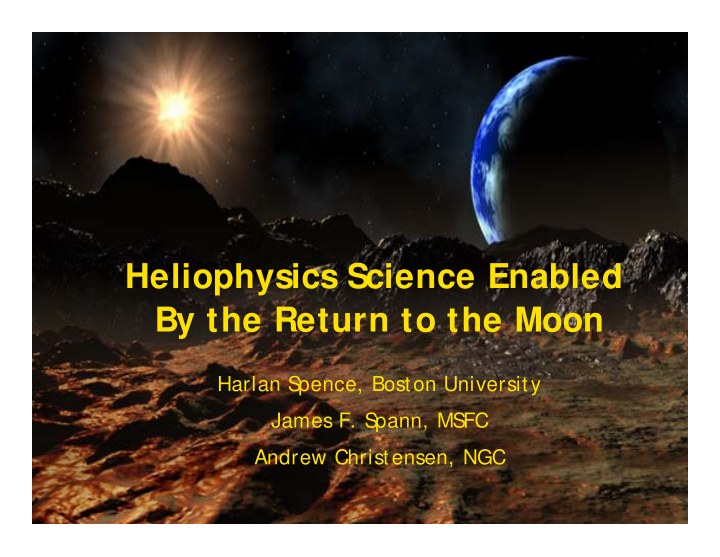



Heliophysics Science Enabled By the Return to the Moon Harlan S pence, Boston University James F. S pann, MS FC Andrew Christensen, NGC
What is “ Heliophysics” ? (in the context of VS E) The realm of heliophysics is the perilous ocean through which explorers, both robotic and human, must j ourney to reach the dusty shores of the Moon, then Mars.
Our Moon is influenced by the S un, a main-sequence star midway through its stellar life. The S un's influence is wielded through radiation, the solar wind, and magnetic fields. Through the eyes of multiple spacecraft, we see the S un, Earth, and Moon as a single, interconnected system moving through interstellar space. Heliophysics seeks to understand how and why the S un varies, how the Earth and Moon responds, and how human activities in these environments are affected.
Explorer 1, 1958 W. Pickering W. von Braun J. Van Allen • The Heliophysics community has been investigating the region of space in which the Moon resides since the inception of NAS A • It is well qualified to address compelling science problems enabled by the return to the Moon
Heliophysics S cience and the Moon • NAS A asked the NAS A Advisory Council – the NAC – to provide scientific and technical recommendations relevant to planning the S cience Architecture and Activities associated with Lunar Exploration within the framework of the Vision for S pace Exploration. • The Heliophysics S ubcommittee of the NAC, is supporting this effort by defining, for heliophysics science, potential activities and obj ectives of science associated with, or enabled by lunar exploration
Heliophysics S cience and the Moon The Heliophysics S ubcommittee approached this task by forming a subpanel. S tarting in July ‘ 06, the subpanel solicited input from the science community; this report is the work of that subpanel. Heliophysics Science and the Moon Subpanel Members: James Spann (lead) NAS A Marshall S pace Flight Center Gordon Emslie Oklahoma S tate University Harlan S pence Boston University Phil Goode New Jersey Institute of Technology Tim S tubbs Univ. of Maryland Michael Kaiser NAS A Goddard S pace Flight Center Andy Christensen Northrup Grumman Pontus C-Brandt JHU/ APL Lynn Kistler Univ. of New Hampshire plus participating members of the Heliophysics S ubcommittee
Heliophysics S cience at the Moon • The Moon and orbits about the Moon offer useful platforms for a renewed emphasis on in-situ measurements and imaging of important space plasma phenomena from the S un to the edge of the heliosphere. • While no lunar-based measurements were recommended in the 2003 S olar and S pace Physics decadal survey, several high-priority science obj ectives of the survey can be addressed with lunar-based measurements.
Heliophysics S cience at the Moon • Measurements of phenomena such as lunar crustal magnetic fields, dust-plasma interactions, and interactions of plasmas and energetic particles with the lunar regolith, while of secondary importance to heliophysics, nevertheless would provide important and even crucial information for lunar surface exploration missions. • Opportunities identified by the heliophysics community are described in this presentation.
Heliophysics S cience at the Moon S cience community efforts to explore the range of priority potential Heliophysics science topics have defined four themes: 1) Space Weather, Safeguarding the Journey 1) Space Weather, Safeguarding the Journey 2) Heliophysics Science of the Moon 2) Heliophysics Science of the Moon 3) The Moon as a Historical Record 3) The Moon as a Historical Record 4) The Moon as a Heliophysics Science 4) The Moon as a Heliophysics Science Platform Platform
S pace Weather, S afeguarding the Journey Interaction of dust and S pace weather impacts Radiation bombardment plasma on the surface of the on robotic and human on the lunar surface Moon and in the exosphere productivity and subsurface
Heliophysics S cience of the Moon Lunar crustal magnetic Plasma and neutral Magnetotail dynamics environments at lunar orbit fields and their origin
The Moon as an Historical Record History of the S un, History of the Inner Composition of cosmic radiation, and S olar S ystem According the solar wind local interstellar medium to Lunar Cold Traps
Moon as a Heliophysics S cience Platform Imaging of the Low-frequency S un's Role in Heliospheric Boundary radio observations Climate Change
Moon as a Heliophysics S cience Platform High-Energy S olar Ionosphere/ Magnetosphere Observatory and an Optical Imaging S olar Observatory
S olar and S pace Physics at the Moon: S ummary • The lunar surface and lunar orbits provide excellent vantage points for investigating the lunar environment , particularly crustal magnetization and dust-plasma interactions. • Excavation of the lunar regolith could provide unique and unprecedented data on the particle and irradiance history of the Sun . • The lunar surface and lunar orbits offer excellent vantage points for imaging of the S un, Earth and planetary magnetospheres and ionospheres, and the outer boundaries of the heliosphere. • Lunar-based instrumentation would allow measurements of plasma transport in the magnetotail and would provide important space weather monitoring capabilities in support of exploration missions.
Thank you! The realm of heliophysics is the perilous ocean through which explorers, both robotic and human, must journey to reach the dusty shores of the Moon, then Mars.
Recommend
More recommend